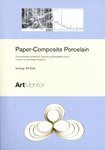
endast ny
Paper-Composite Porcelain : characterisation of Material Properties and Workability from a Ceramic Art and Design Perspective
Paper-composite porcelain is a type of paper clay which is made by combining any kind of porcelain with paper. Paper is added to clay to improve low green strength and plasticity - two of the main practical problems of working with porcelain. Despite widespread interest in the material, the characteristics of paper- composite porcelain have remained undetermined. The purpose of this research was to understand the artistic applicability of, and obtain reliable knowledge of the properties of paper-composite porcelain. The research involved a combination of practical artistic experiments and laboratory experiments used within material science. The artistic experiments investigated the workability and applicability of paper-composite porcelain with different amounts of paper in various casting models. The technical studies qualitatively investigated the material characteristics and microstructures using Xray diffraction and scanning electron microscopy. The qualitative physical properties tests involved different casting body recipes, production methods and firing temperatures. Quantitative studies were used to measure and analyse the properties of porcelain and paper-composite porcelain. The artistic experiments involved the development of a slip casting method which recycled the excess water from the process. Slip casting of various tableware models showed that there was significantly less cracking, warping, bending and deformation of the paper-composite porcelain than of the mother porcelain. Furthermore, sharp angles and fine lines and surfaces were obtained even with the highest paper-fibre content used (90% in volume). Paper-composite porcelain had the same whiteness as ordinary porcelain, but it had a silkier lustre and was more translucent when glazed. Fibrous structures were identified in both green and fired states. It was proved that the presence of paper fibre, the paper type and the paper-fibre content were the factors behind the increased green strength of the paper-composite porcelain. In comparison, paper-composite porcelain has higher green strength, lower shrinkage, lower deformation degree and wider firing range. The results provide new knowledge of paper-composite porcelain by identifying the reinforcement role of paper fibre in the formation and fabrication stages. They also demonstrate a practically tested and documented method for slip casting which shows some of the potential application of paper-composite porcelain in artistic practice.
Utgiven: 2006
ISBN: 9789197591126
Förlag: Art Monitor
Format: Häftad
Språk: Engelska
Sidor: 164 st
Paper-composite porcelain is a type of paper clay which is made by combining any kind of porcelain with paper. Paper is added to clay to improve low green strength and plasticity - two of the main practical problems of working with porcelain. Despite widespread interest in the material, the characteristics of paper- composite porcelain have remained undetermined. The purpose of this research was to understand the artistic applicability of, and obtain reliable knowledge of the properties of paper-composite porcelain. The research involved a combination of practical artistic experiments and laboratory experiments used within material science. The artistic experiments investigated the workability and applicability of paper-composite porcelain with different amounts of paper in various casting models. The technical studies qualitatively investigated the material characteristics and microstructures using Xray diffraction and scanning electron microscopy. The qualitative physical properties tests involved different casting body recipes, production methods and firing temperatures. Quantitative studies were used to measure and analyse the properties of porcelain and paper-composite porcelain. The artistic experiments involved the development of a slip casting method which recycled the excess water from the process. Slip casting of various tableware models showed that there was significantly less cracking, warping, bending and deformation of the paper-composite porcelain than of the mother porcelain. Furthermore, sharp angles and fine lines and surfaces were obtained even with the highest paper-fibre content used (90% in volume). Paper-composite porcelain had the same whiteness as ordinary porcelain, but it had a silkier lustre and was more translucent when glazed. Fibrous structures were identified in both green and fired states. It was proved that the presence of paper fibre, the paper type and the paper-fibre content were the factors behind the increased green strength of the paper-composite porcelain. In comparison, paper-composite porcelain has higher green strength, lower shrinkage, lower deformation degree and wider firing range. The results provide new knowledge of paper-composite porcelain by identifying the reinforcement role of paper fibre in the formation and fabrication stages. They also demonstrate a practically tested and documented method for slip casting which shows some of the potential application of paper-composite porcelain in artistic practice.
Ny bok
260 kr273 kr
5% studentrabatt med Studentapan
Begagnad bok (0 st)
Varje vecka tillkommer tusentals nya säljare. Bevaka boken så får du meddelande när den finns tillgänglig igen.



